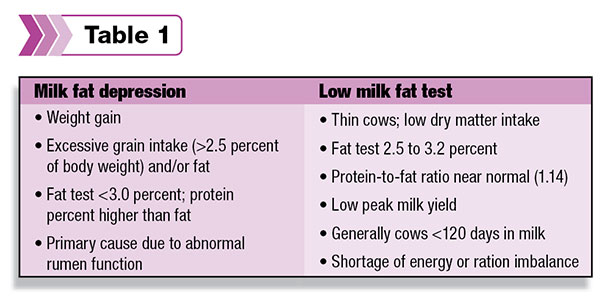The decrease in milkfat production on a 1,500-cow New York dairy occurred a little at a time. Point-by-point, fat production quietly slipped away – not setting off any alarms or concerns, but eroding nonetheless.
The lowered production simply seemed “normal.” The slide was so insidious and happened so slowly, the dairy owner and his management team didn’t notice it until the herd’s milkfat test hit 3.2 percent – and stayed there.
Just a few years earlier, the herd’s milkfat production held steady around 3.7 percent or a little higher. But that was then. Now the herd faces a low milk component scenario that is all too common.
Everybody notices big dips in performance. But slowly sinking milkfat production gradually becomes accepted since the losses are not as instantly dramatic – and dairies may struggle with strategies to overcome reductions.
For farms that are paid on components, slipping milkfat production can become a significant lost income opportunity.
But you do not have to accept suppressed milkfat levels as normal in your herd. Instead, search for ways to optimize milkfat production.
Search for solutions
Part of the challenge is that there are many influencers on milkfat production including rumen buffering, ration fat source, excessive ration sorting, larger less frequent meals, overcrowding, forage-to-concentrate ratio, stage of production, parity, seasonality, genetics, diseases like mastitis and more.
Far and away, reduced rumen pH due to highly fermentable diets is the biggest contributor to lower milkfat production. That’s because today’s diets include more fermentable carbohydrates along with minimized fiber (physically effective neutral detergent fiber) levels.
In short, rations rely more on microbial protein and fermentation than in the past.
Variable feed ingredient quality also plays a role in ration performance and can lead to rumen upsets due to fluctuating pH levels.
“The optimal rumen pH should be between 6.0 and 6.2, but there is daily fluctuation below this level even in healthy cows,” explains Gabriella Varga, animal science professor at Penn State University.
The length of time pH is low, and the number of bouts below 5.5 are what impact clinical and subclinical cases of rumen acidosis as well as impact milkfat production.
In addition, feeding high-grain, low-roughage rations encourages milk production but depresses milkfat percentages, especially when roughage is restricted to 30 percent or less of the dry matter fed.
Generally speaking, when rations include ground, rolled, heated, steam-flaked or pelletized grain, it increases starch digestibility and propionic acid production in the rumen.
Furthermore, the variable amounts of fatty acids from feeds like dried distillers grains with solubles (DDGS), gluten and hominy, cottonseed and other oilseeds, combined with increasing dietary starch and other fermentable feeds, can contribute to lower milkfat production, too.
Also keep in mind that there’s a difference between milkfat depression and low milkfat production (Table 1). Nutritional strategies that follow the same set of principles are key to solving both challenges.
Optimize milkfat production
Take the following steps to overcome low milkfat production and boost herd productivity:
1. Increase inclusion rate of rumen buffers.
The recommended inclusion rate for sodium bicarbonate is 0.75 percent to 1 percent of TMR dry matter. When fed at that rate, a cow eating 60 pounds of dry matter per day should receive at least 0.5 pound of buffer per day – not the 0.25 pound too many cows currently receive.
Rumen buffers help stabilize rumen acids, increasing feed intake while reducing off-feed bouts and improving rumen performance for enhanced productivity. Rumen upset from inadequate buffering is a leading cause of acidosis, which is a top contributor to lower milkfat production.
2. Better manage DCAD levels for high-production and fresh cow diets.
A plethora of data indicate that dairies should take advantage of increased dietary cation-anion difference (DCAD) levels. A 2014 University of Maryland meta-analysis showed a linear response (P less than 0.001) to increasing DCAD levels for a number of important production parameters. For each 10-point increase in DCAD [(sodium + potassium) - (chloride + sulfur)], there increased:
- Milkfat percentage by 0.1 percent
- Milkfat grams per day by 0.35
- Rumen pH by 0.033 units
- Neutral detergent fiber digestibility by 1.5 percent
- Fat-corrected milk/dry matter intake by 0.013
In addition, multiple trials from Clemson University have shown a positive influence on rumen biohydrogenation when a stabilized potassium carbonate source was evaluated.
Research confirms potassium can help reduce the incidence and severity of lower milkfat production by allowing for more of the desirable rumen biohydrogenation pathway to occur.
3. Use wet chemistry analysis to obtain accurate ration nutrient levels.
Don’t rely on book values. The nutrient values – like protein, fiber and starch levels – of various feedstuffs are not consistent from load to load.
For instance, data presented at the 2013 American Dairy Science Annual Meeting showed significant differences in rumen dry matter digestibility and protein bypass, and substantial variation within feeds for soybean meal, canola meal, corn distillers grain, corn gluten, soyhulls and expeller meal.
Also, consider alleviating overcrowding when possible to prevent cows from slug feeding, include milkfat traits in breeding decisions, reduce mastitis incidence and step up feed mixing and delivery management.
While lower milk prices are out of your direct control, you can have an impact on the product you deliver to market. Use this advice to help increase your opportunities to get the most from what milk marketers offer. PD
Joel Pankowski is a manager of technical services with Arm & Hammer Animal Nutrition.
References omitted but are available upon request. Click here to email an editor.

-
Elliot Block
- Research Fellow
- Arm & Hammer Animal Nutrition
- Email Elliot Block
Milkfat optimization checklist
Use this quick guide to help ensure your herd is performing at optimum levels when it comes to milkfat production. This is not an exhaustive list but serves as a starting point when investigating low levels of milkfat production.
- Make sure rations contain adequate levels of effective fiber.
- Formulate rations to ensure proper levels of rumen buffers.
- Monitor daily dry matter intake levels.
- Monitor the total daily intake of ruminally active unsaturated fatty acids.
- Know the unsaturated fatty acid sources used in the ration.
- Monitor ration sugar and starch levels and know the rate of fermentability of starch/sugar feed ingredients.
- Formulate rations so adequate levels of metabolizable protein reach the small intestine.
- Use scientifically proven sources of rumen bypass amino acids.
- Know the levels of potassium, sodium, sulfur and chloride in the ration.Use wet chemistry analysis to determine the nutrient content of all feed ingredients rather than book values.
- Implement rations with negative dietary cation-anion difference (DCAD) for prefresh cows and increase ration DCAD to greater than 35 meq per 100 grams of dry matter post-calving.
- Be sure to formulate rations for potassium levels of 1.7 percent to 2 percent.






